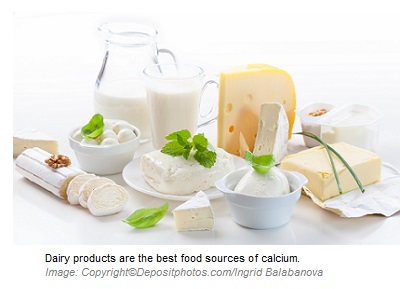Calcium is the most abundant and essential mineral in the body. It  constitutes approximately 1.5 – 2% of the total body weight. About 98% of calcium is in the bones, 1% in the teeth, and 1% in other tissues and blood circulation. A normal calcium level is important for an optimal health.
constitutes approximately 1.5 – 2% of the total body weight. About 98% of calcium is in the bones, 1% in the teeth, and 1% in other tissues and blood circulation. A normal calcium level is important for an optimal health.
Absorption and Blood Level of Calcium:
Total calcium concentration in the blood is 2.2 – 2.6 mmol/dl (8.5 – 10.5 mg/dl). Out of that amount, about 50% is in ionized form and the rest is bound to proteins or complexed with phosphate, citrate, sulfate or other anions.
Despite large changes in daily dietary calcium intake, the daily net calcium absorption from the intestine is relatively constant, which is 5 – 7.5 mmol (200 – 400 mg) per day. Approximately 8 – 10 grams of calcium is filtered by the kidneys every day, of which about 97 – 98% is reabsorbed and only 2 – 3% appears in the urine.
There are many factors that could affect  the absorption of calcium from the GI system.
the absorption of calcium from the GI system.
Factors that increase the absorption of calcium:
- Vitamin D.
- Vitamin A.
- Vitamin C.
- Exercise.
- Enough protein.
- Amino acids: lysine and glycine.
Factors that decrease the absorption of calcium:
- Vitamin D deficiency.
- Stress.
- Lack of exercise.
- Excessive protein intake.
- High fat intake.
- High phosphorous intake.
- Decreased stomach acid.
- Oxalate rich foods (such as spinach, Swiss chard, rhubarb, and beet greens).
- Phytate rich foods (grains and legumes).
- Pancreatic insufficiency.
- Biliary insufficiency.
Food Sources of Calcium:
Calcium is found in many foods, and dairy products are considered good sources. Though many foods contain calcium, the foods with highest amounts have been listed in the following table.
|
Foods |
Serving Size |
Calcium (mg) |
|
Swiss cheese |
2 oz |
540 |
|
Cheddar cheese |
2oz |
410 |
|
Other cheeses |
2 oz |
350 – 400 |
|
Yogurt |
1 cup |
400 |
|
Sardines |
3 oz |
340 |
|
Milk |
1 cup |
300 |
|
Collard greens |
1 cup |
270 |
|
Spinach |
1 cup |
250 |
|
Salmon |
3 oz |
230 |
Functions and Benefits of Calcium:
Being considered an essential mineral, calcium has many life – supporting functions in the body.
- Muscle contraction.
- Heart function.
- Development of bones and teeth.
- Acid – base balance.
- Nervous system function.
- Production of neurotransmitters.
- Blood clotting.
- Regulating blood pressure.
The following conditions may benefit from calcium supplementation:
- Osteoporosis.
- Hyperkalemia (increased blood level of potassium): calcium is given intravenously.
- Pregnancy – induced hypertension.
- Rickets.
- Osteomalacia.
- Premenstrual syndrome (PMS).
- Painful menstruation (dysmenorrhea).
- Celiac disease.
- Weight management.
- Colon cancer.
- Peptic ulcer (as calcium carbonate).
- Migraine.
- Malabsorption syndromes.
Daily Needs and Dosage:
The recommended daily need of calcium depends on age and other factors (see the table below).
|
Calcium Daily Requirements: |
|
|
Age Groups |
Daily need (mg/day) |
|
0 – 6 months |
210 |
|
7 – 12 months |
270 |
|
1 – 3 years old |
500 |
|
4 – 8 years old |
800 |
|
9 – 19 years old |
1300 |
|
20 – 50 years old |
1000 |
|
51 – 70 years old (women) |
1200 |
|
51 – 70 years old (men) |
1000 |
|
Over 70 years old |
1000 |
|
Postmenopausal |
1500 |
|
Pregnancy and breastfeeding, under 18 years |
1300 |
|
Pregnancy and breastfeeding, over 18 years |
1000 |
Calcium supplements are available as bicarbonate, citrate, lactate, and gluconate in the  forms of 500 mg, 600 mg, and 1000 mg. When taking orally, they have different rates of absorption.
forms of 500 mg, 600 mg, and 1000 mg. When taking orally, they have different rates of absorption.
|
Types of Calcium |
Rate of Absorption |
|
Carbonate |
40% |
|
Citrate |
21% |
|
Lactate |
13% |
|
Gluconate |
9% |
Side Effects and Interactions:
Calcium is considered safe in recommended doses. However, higher doses of calcium could cause minor gastrointestinal disturbances, such as constipation, bloating, belching, and gas. Excessive intake of alcohol, protein, caffeine, sodium, and phosphorous increases calcium loss though urine.
Calcium supplementation should be avoided in the following conditions:
- Prostate cancer.
- Kidney stone, oxalate type.
- Hyperparathyroidism.
- Chronic renal failure.
Calcium has interactions with the following medications:
- Ceftriaxone: simultaneous intravenous administration of calcium and ceftriaxone should be avoided, as it could lead to dangerous reactions.
- Antibiotics: quinolones (ciprofloxacin, levofloxacin, norfloxacin and ofloxacin) and tetracyclines (tetracycline, doxycycline, and minocycline): calcium interferes with the absorption of these antibiotics. So, calcium supplements should be taken 2 – 4 hours before or after these antibiotics.
- Bisphosphonates (alendronate, etidronate, risedronate, and tiludronate): calcium interferes with the absorption of these medications and can decrease their effectiveness. Calcium should be taken at least 2 hours before or after them.
- Levothyroxine: calcium decreases its absorption and they should be taken at least 4 hours apart.
- Cholesterol-lowering medications (cholestyramine, colestipol, and colesevelam): they decrease calcium absorption.
- Digoxin: calcium may increase its effects and risk of digoxin toxicity.
- Corticosteroids: you may need to increase your calcium intake.
- Anti-seizure medications (phenytoin, carbamazepine, phenobarbitol, and primidone): they may decrease blood levels of calcium. And also calcium should be taken at least 2 hours before or after taking them.
- Birth control pills: they contain estrogen that can increase absorption of calcium and its effectiveness.
- Diuretics (water pills):
- Thiazides: they increase blood levels of calcium.
- Loop diuretics (furosmide and bumetanide): they decrease blood levels of calcium.

